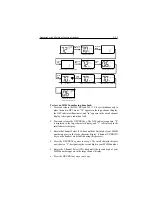
3-30
Operation with Minimum Function Handset
3.5.18.6
Distress Relay Call
Sometimes a ship’s distress call can be relayed from another ship or a
shore station. Because it is Class “D” DSC compliant, the RAY215E can
receive a Distress Relay Call but cannot acknowledge or relay the call.
If the radio is active on a working channel or private channel, in the Monitor
mode, or in the Scan mode when a Distress Relay Call is received, the
unit automatically enters DSC mode and emits an alert tone. The DSC
indicator illuminates, 70 is indicated on the large channel display, and
“dr” flashes on the small channel display.
Press and release DSC/PRI. The unit switches to channel 16. “16” appears
as the working channel on the large channel display while the small channel
display is extinguished. The DSC indicator is also extinguished, indicating
the unit has exited the DSC mode.
The alert tone continues to sound until DSC/PRI is pressed to accept the
call or 16 key is pressed to exit the DSC mode.
You should attempt to contact the vessel in distress on channel 16 and
render assistance.
Switch to Channel 16
PRESS & RELEASE
DSC
Distress Relay Call received
3.5.19
ATIS ID No. Entry
The Automatic Transmission Identification System (ATIS) is used in some
European countries to identify vessels in their inland waterways. After
the PTT key is released following a transmission, the vessel’s ATIS ID
number is also transmitted.
You must enter your ATIS ID number into the RAY215E before the ATIS
system will be operational. You can request an ATIS number when you
apply for a radio license.
Regulations in some regions may not allow end users to program their
own ATIS number. If this unit was purchased to be used in such a region,
this function will be disabled and the programming must be done by your
authorized Raymarine dealer/distributor.
Summary of Contents for Ray215e
Page 1: ...O w n e r s H a n d b o o k VHF Radio Ray215e...
Page 2: ...RAY215E Modular VHF Radio Owner s Handbook Document number R49018_2 Date April 2002...
Page 3: ......
Page 23: ...2 10 Installation Figure 2 6 Typical Grounding Method...
Page 115: ...4 60 Operation with Full Function Handset...
Page 121: ...5 6 Maintenance This page intentionally left blank...
Page 122: ...5 7 Maintenance 5 4 Drawings Assembly Drawing...
Page 123: ...5 8 Maintenance Block Diagram RF PCB...
Page 124: ...5 9 Maintenance Control PCB...
















































